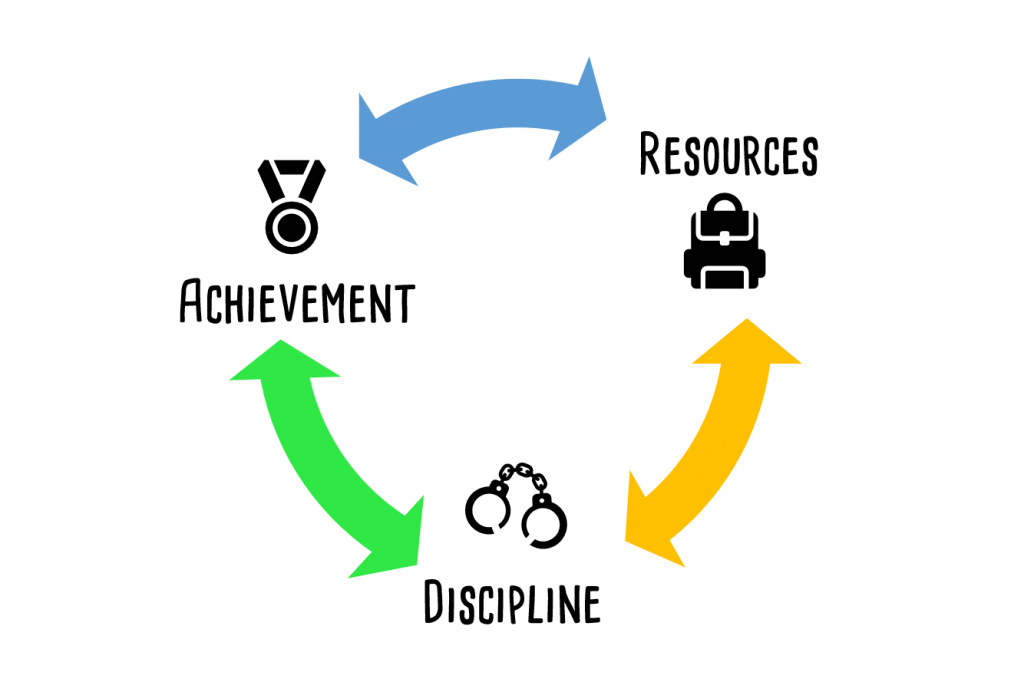| Go Back: Module 13: Allies and Antiracism | You Are Here: Module 14: (In)Equity in the Educational System | Next: Module 15: (In)Equity in Libraries |
AFTER WORKING THROUGH THIS MODULE, YOU WILL BE ABLE TO:
- Define educational debt and give some examples of opportunity gaps faced by youth of color and Indigenous youth in the public school system.
- Investigate discipline, resource, and achievement gaps in your own school, library, and/or district.
Introduction
The phrase “achievement gap” is one of the most commonly used expressions in the educational research and policy world. This phrase serves as shorthand for the widespread and persistent disparities in standardized test scores between Black, Latinx, and Indigenous students and their Asian and white peers. But questions about the “achievement gap” have become more prominent in recent years, with educators, researchers, parents, and students alike challenging this narrative for implying that it is students of color and their families who are failing, rather than schools and school systems failing them. In this module, we will explore racial inequities in the public school system related to resources, discipline, and academic achievement from a systemic perspective, focusing on how institutional racism is woven into the U.S. public school system in ways that limit the opportunities and choices of BIYOC.
 Read
Read
In 2006, educator and researcher Gloria Ladson-Billings delivered the Presidential Address at the American Educational Research Association’s (AERA) annual conference. Her speech, titled “From the Achievement Gap to the Education Debt: Understanding Achievement in U.S. Schools,” focused on the shortcomings of the “achievement gap” narrative, and proposed instead that we understand achievement disparities between BIYOC and white students as one outcome of the education debt that we owe racialized youth as a result of decades of legal, economic, educational, and social oppression. Read her address here [PDF].
 The Resource Debt: Interact
The Resource Debt: Interact
Take the short quiz below to explore some of the resource disparities in U.S. public schools.
 Watch
Watch
Kandice Sumner puts a face to the resource gap data in her TED Talk, where she shares her experiences as a public school teacher in Boston. Watch this video and/or read the transcript (linked below). As you watch, think about how the resource inequities Sumner describes might be related to the more frequently discussed “achievement gap.”
 Read
Read
Read the 2022 Education Trust report Equal is Not Good Enough: An Analysis of School Funding Equity Across the U.S. and Within Each State[PDF]. Be sure to explore the funding gap data provided for your own state.
National reports like the one above often do not include much data on Native youth because their overall numbers are so much smaller than the numbers of Black and Latinx youth. However, Native students are subject to some of the most severe resource inequities in the nation. Read the two pieces below to learn more about educational inequities facing Native students:
- 2014 Native Youth Report [PDF]: Commissioned by Barack Obama, this report provides an overview of the obstacles facing Native youth on their path to educational success.
- How America Is Failing Native American Students: In this article from The Nation, Rebecca Claren describes how inadequate funding, discipline disparities, and poor curricula have created an educational crisis for Native youth.
- The Federal Government Gives Native Students an Inadequate Education, and Gets Away With It: In this article from ProPublica, Alden Woods details the historical and present failures of the Bureau of Indian Education.
 The Discipline Debt: Interact
The Discipline Debt: Interact
Take the short quiz below, based on federal data from the U.S. Office for Civil Rights, to explore some of the discipline disparities in U.S. public schools.
 Read
Read
The data used in the quiz above comes primarily from two sources, each of which summarizes data collected by the U.S. Department of Education’s Office for Civil Rights. Read each of the research briefs below to explore more of the numbers related to U.S. discipline disparities. As you read, ask yourself:
- Which groups of students are most impacted by discipline disparities?
- Why might this be the case? Try to connect your thinking here to our explorations of systemic and historical inequities from Modules 2 and 5, and our discussion of implicit bias in Module 4.
Discipline Disparities: A Research-to-Practice Collaborative [PDF] Executive Summary; full reports and additional resources can be accessed here.
2015-2016 School Climate and Safety Report [PDF] from the U.S. Department of Education’s Office for Civil Rights
 Reflect
Reflect
When faced with discipline disparities like these, many people argue that students of color – in particular, Black students – are simply more poorly behaved than white students. At this point in the curriculum, we have explored several topics that might help you effectively counter this argument, including:
- the historical association between blackness and criminality that arose after the Civil War as a result of the prison labor system (Module 2);
- the systemic connections between the criminal justice system and the education system (Module 5);
- implicit biases and their relation to stereotypes and media messaging (Module 4);
- racial identity development frameworks (Module 9).
In your journal, compose a response to the argument that students of color are simply “bad.”
 Read
Read
In addition to the false claim that students of color simply behave worse than white students, many other myths and misconceptions plague discussions of discipline disparities. These include the idea that discipline disparities are really more about poverty than race; that suspension and expulsion are rare and reserved only for serious offenses; that disparities are solely the result of individual teachers and principals; and that there is nothing schools can do to reduce these disparities because they are required to respond to violent behavior in specific ways. A wide body of research has addressed each of these ideas. For a summary response to each of these arguments, read the Discipline Disparities: Myths and Facts [PDF] fact sheet from The Equity Project at Indiana University.
It’s important to note that similar disciplinary actions can result in varied consequences for students. For example, when an undocumented student is involved in a fight that is broken up by a school resource officer, that student risks not only suspension but possible deportation. For more about this, read Coshandra Dillard’s article for Learning for Justice (formerly known as Teaching Tolerance) titled “The School-to-Deportation Pipeline.”
 Explore
Explore
What does the discipline data look like in your local area? The Office for Civil Rights collects and publishes data on 17,337 school systems and 96,360 schools, and maintains a set of data analysis tools that you can use to easily view this data by school, district, and/or state. Explore the data for your local area and/or school at https://civilrightsdata.ed.gov/. How does it compare to the national data? If you are employed in a school, you may also have access to additional internal data sources related to student discipline. Explore that data as well to see which groups are most impacted by discipline disparities in your community.
 Act
Act
The Equity Project at Indiana University has published a brief report summarizing academic research into successful interventions that show promise for reducing racial disciplinary gaps. Read their report here [PDF].
For School Librarians: Think about which of these interventions may work in your school or district. Which might you be able to implement on your own? Which would require school- or district-level support to implement? Plan to start these conversations with the administrators in your school or district.
For Public Librarians: Work with teachers and/or school administrators in your area to find out which, if any, interventions are being implemented there to lessen discipline disparities. Think about whether and how the library might support these interventions.
Keep in mind that the library itself is not immune from discipline issues! We will discuss these in the next module, (In)Equity in Libraries. For other ideas about how to address discipline inequities, see the But Wait! section below, which introduces some resources on restorative justice.
Watch
One elementary school in Baltimore has implemented an innovative response to student discipline: meditation. Watch the video below and, if you work in a school, reflect on whether this is something that your school may consider implementing. If not, could you implement it in the library?
The transcript for this video can be located here.
 The Achievement Debt: Interact
The Achievement Debt: Interact
Work through the quiz below to explore data related to the achievement debt. As you explore these statistics, try to view them in light of the resource and discipline debts discussed above.
 Read
Read
The academic achievement gap between Black, Latinx, and Native students and white students has been used to justify racist behaviors and beliefs about people of color, and as evidence that people of color are somehow innately inferior to white people. Read Melinda D. Anderson’s article “How the Stress of Racism Affects Learning” for a different, research-backed explanation for the achievement gap that positions institutional racism as the root cause of these differences.
 Explore
Explore
The data presented in the slideshow above represent national averages; your local schools may have smaller or larger achievement gaps among the various racial groups they serve. NAEP offers state- and district-level achievement data in reading and math. However, the most comprehensive achievement data will likely come directly from your state’s education department, which is required under federal law to publish achievement data by race under the Every Student Succeeds Act (ESSA). Use the links below to explore the data from the schools around your library. Some states provide lots of additional data for each school that you may also find useful to explore. You may also find it helpful to visit your school district’s website; many districts collect and publish additional data not included in state reports.
 Reflect
Reflect
None of the race-based gaps/debts we’ve discussed in this module can be understood or explained in isolation. In your journal, reflect on how these three forms of educational inequity – the resource debt, the discipline debt, and the achievement debt – work together and shape one another.
 Watch
Watch
Watch the video below from the Crash Course on Sociology series, which puts together the information we’ve explored related to school discipline, resources, and achievement to show how the U.S. school system both creates and perpetuates racial and socioeconomic inequity.
 But Wait!
But Wait!
In this section, we address common questions and concerns related to the material presented in each module. You may have these questions yourself, or someone you’re sharing this information with might raise them. We recommend that for each question below, you spend a few minutes thinking about your own response before clicking the arrow to the left of the question to see our response.
Many schools are being pressured to reduce suspension rates, especially for students of color. But if students misbehave, what else are schools supposed to do? After all, they have the safety of other students to think about too.
It’s true that for some serious offenses, such as bringing a weapon or drugs to school, schools are often required to suspend or expel students. However, students are frequently suspended for offenses such as “defiance,” “disrespect,” or “disruptive behavior.” These offenses are subjective; what one teacher considers disrespectful may be considered humorous in another classroom and evidence of critical thinking in a third. Cultural differences in communication styles can also lead to teachers misinterpreting or overreacting to student behavior, and since most teachers are white females, this especially affects Black and Latinx males. For more on this, listen to the five-minute KUT radio segment below, in which University of Texas College of Education professor Richard Reddick and Seattle Central Community College professor Daudi Abe discuss cultural factors that underlie the discipline gap, or read the transcript:
So what can schools do instead of suspending these students? One possible response is the practice of restorative justice, which focuses on building relationships and repairing harm rather than punishment. Read more about restorative justice in schools in this Cult of Pedagogy article by Jennifer Gonzalez (which also includes an audio version). Restorative justice practices not only address individual acts of misbehavior in a positive way, but they can also help create an overall school culture of mutual respect such that problematic behaviors are minimized from the start. Teachers should also be educated about culturally responsive pedagogy and implicit bias so they can better understand and communicate with their students of color and Native students.
The 'achievement gap' narrative is so pervasive - it's even in the law! How do I shift the language around this issue in my workplace?
You could start by sharing the information and resources presented in this module. If you work in a school, you likely examine your testing data each year. This is a great opportunity to shift the language and start questioning some of the assumptions we make about why BIYOC score lower on these tests, in general, than their white and Asian American peers. Instead of looking at this data from a lens that asks “what does this data say about the kids?,” ask instead “what does this data say about us as teachers? What does it say about our school? What does it say about the educational system?”
 Additional Resources
Additional Resources
- School-to-prison pipeline for Native Youth [PDF]: An infographic created by the National Congress of American Indians (NCAI)
- The Challenge of Educational Inequality by Ronald Brownstein for The Atlantic
- Race and Inequality in Education: A resource site created by the ACLU
- How COVID taught America about inequity in education by Clea Simon for The Harvard Gazette
| Go Back: Module 13: Allies and Antiracism | You Are Here: Module 14: (In)Equity in the Educational System | Next: Module 15: (In)Equity in Libraries |
